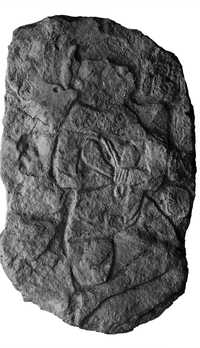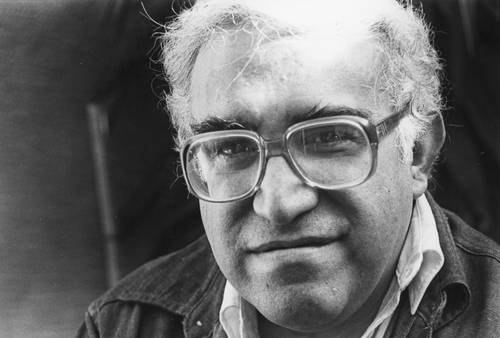The discovery of a carved panel at Calakmul would rethink the idea of the site's extent.

The discovery of a carved panel at Calakmul would rethink the idea of the site's extension.
The piece was used by the ancient Mayans as a building material for the wall in a water reservoir.
Reyes Martínez Torrijos
La Jornada Newspaper, Thursday, June 19, 2025, p. 2
Three days ago, a carved panel was discovered on a limestone slab in the archaeological site of Calakmul, Campeche, depicting a man likely held captive. This discovery could lead to a rethinking of the extent of the site and what urban areas were like in the Mayan world, Adriana Velázquez Morlet, director of the INAH Center in that state, told La Jornada .
In an interview, the archaeologist mentioned that the piece is almost 1.2 meters long by about 50 centimeters wide and was part of a larger sculptural project whose original location is unknown, but it was used by the ancient Maya as construction material for the wall of a water reservoir.
Kathryn Reese-Taylor, who heads the Under Labyrinth Archaeological Project, detailed to this newspaper the investigations on the aforementioned wall, which includes panels of captives (where the found piece comes from) and has so far been dated between the 7th and 8th centuries AD.
Calakmul means "two adjacent mounds"
in Mayan, referring to the majestic structures that dominate the jungle. Although it was discovered in the early 1930s, it was not until systematic research in the 1980s that it was understood to be one of the capitals of the Classic Maya period, between the 3rd and 10th centuries AD.
The city, inscribed on the United Nations Educational, Scientific and Cultural Organization's World Heritage List, maintained a strong political rivalry with Tikal for nearly a century, and various hieroglyphic studies record the history of wars between the two.
Adriana Velázquez explained that the initial inspection and cleaning of the found piece is underway. She added that this discovery strengthens our understanding of this iconographic project of the captives, which has been under investigation since last year
.
He defined it as a panel that perhaps corresponds to a wall whose exact location archaeologists do not know, but it was a very large iconographic program
, which very possibly recorded war conflicts and Calakmul as a large political entity that had enormous influence in large regions."
Glyphs have been identified on the monolith, possibly representing places and the names of the imprisoned figures. "It can be associated with different conflicts. There was a war between Calakmul and Dzibanché, within the same Kaanu'l family, and also one with Tikal. The next step is for researchers to try to associate these findings with specific events."
Velázquez Morlet emphasized that the piece and others under investigation could add information to what is known about Calakmul and cities such as Olvidado, Pared de los Reyes, Yaxnocah, Laberinto, and Taxil , which formed a huge urban complex. This would force us to rethink the idea of what a limited archaeological site is, because it is a very large continuum of structures, which has been identified through Lidar imaging studies
.

▲ The limestone slab depicts a man, probably a captive, and was part of a larger sculptural project whose original location is unknown. Photo courtesy of the INAH
The piece is associated with the commemoration and display of the power of the ruling Kaanu'l dynasty, and is also part of a very large wall celebrating military victories over a population still unknown at the time when Calakmul would have been perhaps the largest and most powerful city in the entire Mayan area.
Loss of symbolic value
The archaeologist commented that having found it in the excavations of a later construction means that they ceased to have importance, since the panels were used only as a construction material, no longer having symbolic value
.
Kathryn Reese-Taylor reported that the Bajo Laberinto Archaeological Project has identified several panels located in a visible position "in the water, beneath clay, mud, and were already part of a construction. They don't commemorate the Kaanu'l victory, they don't show its importance; they don't have the same value in this period as they had during the Late Classic."
On these stones, captives are seen: their hands are tied, their hair is bare, and they are almost naked. They can be seen in uncomfortable positions, with twisted necks. On the stelae, the kings are dressed in very elegant robes. The captives are not; they are in humiliated positions
.
He surmised that these walls were very interesting in their location. As an architectural element, I think of them as the center of the site, perhaps the Great Acropolis of Calakmul. We're looking for where they were. Every year we learn more about this narrative of a very important conflict
.
Reese-Taylor predicted that after analysis by specialists, such as archaeologist and anthropologist Félix Kupprat of the National Autonomous University of Mexico, "we'll know who was the king during this war. We're still in the field and haven't had time to do much research. I saw the clean honeycomb for the first time today (yesterday). It seems like a great narrative of a very relevant war. We believe it was a war between the Kaanu'l and someone else, but we can't confirm who the adversary was."
Archaeologist Armando Anaya, who co-directs the project, which brings together the University of Calgary, the Autonomous University of Campeche, and the National Autonomous University of Mexico, as well as the National Institute of Anthropology and History, agreed that the carved stones most likely came from one of the palaces where they were originally displayed, at an earlier date. They were reused around the Late Classic period
.
Fifteen years after his departure, all facets of Monsiváis still fascinate.
He analyzed the political reality with precision and had a great understanding of Mexico City's nightlife.

▲ Carlos Monsiváis's work remains relevant and a focus of attention for specialists at the UNAM Faculty of Philosophy and Letters. Photo by Rogelio Cuéllar
Reyes Martínez Torrijos
La Jornada Newspaper, Thursday, June 19, 2025, p. 3
Writer Carlos Monsiváis, whose death marks 15 years today, is fascinating for his many facets and because he always went beyond what could be said about him, said narrator and journalist Elena Poniatowska.
The author recommended reading the entire work of Monsiváis (1938-2010), because, she explained to La Jornada , the chronicler has been the intellectual closest to popular struggles and a person who had a greater capacity to be universal from San Simón Street, where he lived a strict life
.
He explained that he provided an accurate analysis of political and social realities, in addition to having a deep understanding of Mexico City's nightlife. Monsiváis is a major figure, and many people continue to read him. At the National Autonomous University of Mexico, students at the Faculty of Philosophy and Letters continued to read him
. For example, students from the Faculty of Philosophy and Letters said that his work remains relevant and the focus of attention of specialists; one even considered that his texts are on the way to becoming cult classics
.
The contributor to this newspaper added that the analysis of the October 2nd massacre, which the chronicler captured in 1968, the tradition of resistance , is essential to the life of the country
.
The author of La noche de Tlatelolco said he was a very accurate analyst of Mexican reality, and his judgments were very valid, a bit like advice or guidelines to follow. He was more familiar than other analysts with what would happen. To understand the country's reality, you had to consult and read Monsiváis, and follow him
.
The intellectual escaped everything that could be said about him: he went beyond. There are people who surpassed their destiny, and Monsiváis was one of them
, the narrator declared.
Yesterday, Poniatowska presented Nostalgia de Monsiváis at the Palacio de Bellas Artes, an anthology of texts by friends and colleagues dedicated to the chronicler, published by Siglo XXI Editores.
Among the more than 50 books published by the chronicler, the most notable are Días de guardar (Days of Keeping) (1971), Amor perdido ( Lost Love ) (1977), Nuevo catechismo para indios remisos (New Catechism for Remiss Indians ) (1982), Escenas de pudor y frividad (Scenes of Modesty and Frivolity ) (1988), Los rituales del caos (The Rituals of Chaos) (1995), and Aire de familia: Cultura y sociedad en América Latina (Family Airs: Culture and Society in Latin America ) (2000). Some titles are still available from publishing houses such as Era and Penguin Random House.
Javier Aranda Luna reflected that now that Monsiváis has become an icon of the official secular calendar of saints, it would be worth reading him. It would help to understand whether the new catechism applied in his name validates concrete facts of national life. His framework of values, his militancy at first, and later his unrestricted and blindfolded activism made him a moral compass
.
The columnist "believed in what is disdained today: 'democratizing the achievements of elitism (by no means a bad word in my cultural vocabulary)', convinced of its contributions. He criticized the 'meager budgets,' the 'inappropriate projects,' and the 'theoretical confusions regarding populism and elitism,'" the writer noted.
Aranda suggested two books to read by the “baroque Carlos Monsiváis: The New Catechism for Remiss Indians , fables that, more than morals, allow us to participate in an overflowing imagination full of a sense of humor, and The Laws of Wanting , a wonderful chronicle dedicated to Pedro Infante and popular culture so that we can say, due to the absence of Monsiváis as Chachita in Nosotros los pobres : 'now I have a grave to cry on.'”
Journalist and poet Hermann Bellinghausen said that Monsiváis's daily teaching deserves to be remembered, "his democratic exercise of Mexican history, literature, art criticism, political, social, and entertainment reporting. He did cultural journalism on par with José Emilio Pacheco and, like him, was a historian of the public and a disseminator of intellectual secrets. Above all, he taught us to interpret reality with intelligence, humor, and irony."
Both voluntarily and brilliantly joined the tradition of civic chroniclers and writers of Juárez, Modernism, and Modernidad, in which they grew up in the mid-20th century. With a touch of Jacobinism, he defended minority rights and encouraged new trends in inclusion and respect for diversity. He encouraged public debate.
The narrator noted that one problem
with Monsiváis's work is that "it is rooted in fleeting current events. His witty reading of the press and the pronouncements of politicians and local bosses links him to the Viennese Karl Kraus. His lifelong column Por mi Madre Bohemios..., extremely dated by nature, will one day be read as the log of another century, heir to Salvador Novo."
Bellinghausen commented that he was an author "so abundant and widespread, whose books, if anything, are anthologized, demands rescue efforts. We'll have to look for him even in Tele Guía , Chanoc, Fantomas , and La Familia Burrón ."
Next Monday, at 5:00 PM, the tribute "Remembering Carlos Monsiváis" will be held, featuring narrator and essayist Adolfo Castañón. It will be broadcast on the Facebook pages of the National Coordination of Literature and the Alfonsina Chapel.
The UAM-Azcapotzalco will hold the Monsivadian Conference on the life and work of the chronicler until Saturday. Details of the activities can be found on its social media platforms (Facebook and X).
jornada





